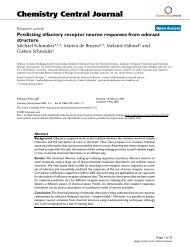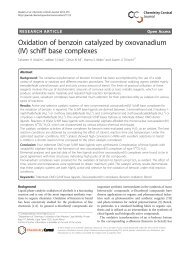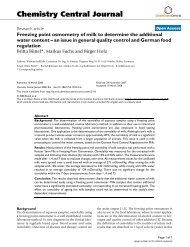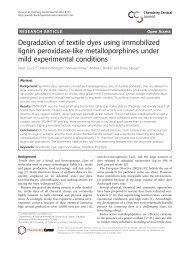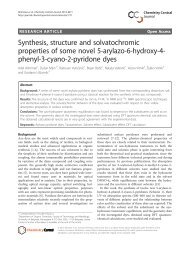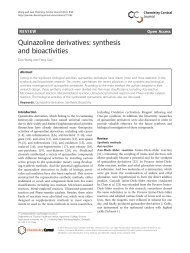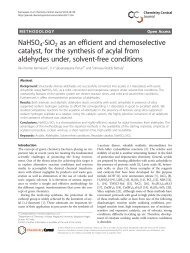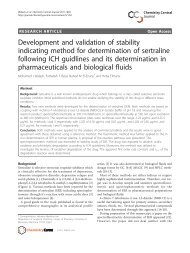Stress degradation studies and development of stability-indicating ...
Stress degradation studies and development of stability-indicating ...
Stress degradation studies and development of stability-indicating ...
You also want an ePaper? Increase the reach of your titles
YUMPU automatically turns print PDFs into web optimized ePapers that Google loves.
Musharraf et al. Chemistry Central Journal 2012, 6:7<br />
http://journal.chemistrycentral.com/content/6/1/7<br />
Analysis <strong>of</strong> marketed samples<br />
In prednisolone acetate eye drops, prednisolone acetate<br />
was found 97% (P1), 100% (P2), 93% (P3), 93% (P4) <strong>and</strong><br />
81% (P5) <strong>of</strong> the label claim. In chloramphenicol eye<br />
drops <strong>and</strong> capsule, the %s <strong>of</strong> chloramphenicol were<br />
found 98 (C1), 95 (C2) <strong>and</strong> 99 (C3). In eye drops, containing<br />
prednisolone acetate <strong>and</strong> chloramphenicol in<br />
combination, the %s <strong>of</strong> chloramphenicol were 96 (PC1)<br />
<strong>and</strong> 95 (PC2) while prednisolone acetate was found<br />
100% in both samples. Two expired pharmaceutical products<br />
were also analyzed. In a expired sample (spersinicol),<br />
peak was not found for chloramphenicol at R f 0.21<br />
(100% <strong>degradation</strong>) but six degraded peaks were found<br />
at R f 0.01, 0.09, 0.19, 0.15, 0.38 <strong>and</strong> 0.58. <strong>Stress</strong> <strong>degradation</strong><br />
study data showed that peak with Rf 0.01 was commonly<br />
formed under all stress conditions. Degraded<br />
products with Rf 0.09 <strong>and</strong> 0.15 were formed by photodegrdation<br />
Degraded products with R f 0.38 <strong>and</strong> 0.58<br />
were not found under any stress condition applied to<br />
chloramphenicol alone. Degraded product with R f 0.38<br />
was generated in combined sample <strong>of</strong> prednisolone acetate<br />
<strong>and</strong> chloramphenicol under acidic hydrolysis (5N<br />
HCl). In expired prednisynth product (light yellow in<br />
color), peak for chloramphenicol was found but with<br />
Figure 6 Chromatogram <strong>of</strong> (a) expired spersinicol <strong>and</strong> (b)<br />
expired prednisynth at 278 nm.<br />
Page 8 <strong>of</strong> 9<br />
59% <strong>degradation</strong> <strong>and</strong> prednisolone acetate was degraded<br />
up to 72.2%. Five additional peaks were also found at R f<br />
0.01, 0.15, 0.26, 0.38 <strong>and</strong> 0.58 (Figure 6). Comparison<br />
showed that degraded product at R f 0.01 was a common<br />
product in both, individual <strong>and</strong> in combination.<br />
Degraded products at Rf 0.15 <strong>and</strong> 0.38 were generated<br />
by the <strong>degradation</strong> <strong>of</strong> chloramphenicol. Degraded products<br />
with R f 0.26 (found under dry <strong>and</strong> wet heat <strong>degradation</strong><br />
conditions) <strong>and</strong> 0.58 (produced under acidic<br />
hydrolysis <strong>and</strong> photo <strong>degradation</strong>) were associated with<br />
the <strong>degradation</strong> <strong>of</strong> prednisolone acetate (Table 5).<br />
Conclusions<br />
A validated TLC method for routine analysis to determine<br />
the <strong>stability</strong> <strong>of</strong> prednisolone acetate <strong>and</strong> chloramphenicol<br />
in pharmaceutical dosage forms has been<br />
developed. Current study demonstrates the <strong>degradation</strong><br />
susceptibility <strong>of</strong> drugs to different stress conditions <strong>and</strong><br />
thus helps in determining the changes in chemical, physical<br />
<strong>and</strong> microbiological properties <strong>of</strong> the drug samples<br />
with time. It also helps in underst<strong>and</strong>ing the mechanism<br />
<strong>and</strong> pathway <strong>of</strong> degraded products formation <strong>and</strong> in<br />
developing a pr<strong>of</strong>ile reflecting the changes in identity,<br />
purity <strong>and</strong> potency <strong>of</strong> the product. The comparison <strong>of</strong><br />
stress <strong>degradation</strong> in individual <strong>and</strong> combined formulations<br />
reveals the effect on % <strong>degradation</strong> <strong>and</strong> the number<br />
<strong>of</strong> degraded products. The developed <strong>stability</strong><br />
<strong>indicating</strong> TLC method is simple, reproducible <strong>and</strong> can<br />
be used for the simultaneous analysis <strong>of</strong> two active components<br />
(chloramphenicol <strong>and</strong> prednisolone acetate). It<br />
appears suitable for routine analysis <strong>of</strong> these components<br />
selectively in presence <strong>of</strong> their degraded products<br />
in individual <strong>and</strong> in combined pharmaceutical<br />
formulations.<br />
Table 5 Analysis <strong>of</strong> pharmaceutical products.<br />
Product Prednisolone acetate Chloramphenicol<br />
Conc. (in %<br />
Conc. (in %<br />
ng) Degradation ng) Degradation<br />
P1 2909.94 3.002 - -<br />
P2 3000 0 - -<br />
P3 2778.6 7.38 - -<br />
P4 2803.05 6.565 - -<br />
P5 2440.5 18.65 - -<br />
C1 - - 2956.5 1.45<br />
C2 - - 2850.9 4.97<br />
C3 - - 2984.4 0.52<br />
PC1 3000 0 1158.72 3.44<br />
PC2 3000 0 1144.44 4.63<br />
EC1 - - 0 100<br />
EPC1 833.55 72.215 490.05 59.15





